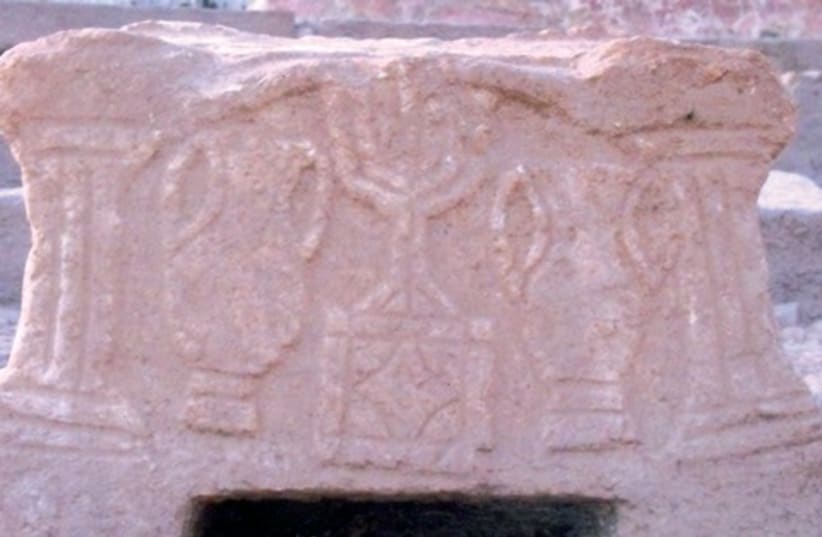Father Juan Maria Solana fondly recalls the day three years ago when salvage archeologists from the Israel Antiquities Authority told him that the 122-room pilgrimage center the Legionaries of Christ were developing at Migdal on the shores of Lake Kinneret would have to be redesigned at a considerable delay and cost – because of the discovery of the ruins of a 2,000-year-old synagogue and a stone carved with a seven-branched menorah likely based on the candelabrum in Herod’s temple in Jerusalem.“I knew that Magdala was a holy place and I always had the sense that it would be a special place for the pilgrims from different religions. But these new findings certainly surpass our expectation. In a moment of prayer in this place, I thought that the last time the faithful gathered here, around 70 AD, most of them had been witnesses of the life of our Lord,” he says.“I’m dreaming of the day when this place opens for pilgrims to visit, and I hope it will serve to build bridges of dialogue and ties of true love between the believers of different religions in the Holy Land.”
Solana, the Puebla, Mexico-born director of the Pontifical Institute Notre Dame of Jerusalem Center and initiator of the Magdala Project, says the new pilgrimage center is now slated to open in late 2013. The site – equidistant between Capernaum and Tiberias – marks the town of Migdal, which was the home of Mary Magdalene. Migdal, meaning “tower” in Hebrew, was called Magdala in Aramaic and Taricheae, meaning “the places where the fish are prepared,” in Greek. The city was home to a community of fishermen in Jesus’s time. According to the Jewish historian Josephus Flavius, Migdal was destroyed and 40,000 of its residents were slaughtered during the Great Revolt against Rome in 67 CE.The Magdala Project was conceived when the Legionaries of Christ arrived in Israel in 2004, after pope John Paul II asked them to take charge of the Pontifical Institute Notre Dame of Jerusalem Center, a luxurious pilgrimage center run by the Vatican in a restored 19th-century French hospice.Solana explains that the idea of the Magdala Project was to offer pilgrims an additional place of prayer and hospitality in the Galilee, to complement the services of the Notre Dame Center in Jerusalem.The center, which is being built by the Church’s Ark New Gate Company, will comprise a luxurious hotel for pilgrims; a multimedia center dedicated to the message and life of Jesus, Mary Magdalene and the history of the site; and meditation gardens landscaped around the lakeshore and the archeological remains.Though it is being built as a Roman Catholic pilgrimage center, Solana hopes the new center will serve as an ecumenical place of meeting. Honoring the site’s connection to Mary Magdalene, the center will highlight the role of women in the Gospel and other religious texts. The center will conduct seminars, conferences and retreats for women as well as youth. In addition, the pilgrimage center will provide 360 permanent jobs and 1,000 indirect jobs for local Christians in the Galilee.Key to all that will be the preserved ruins of the Second Temple-period synagogue, which measures 120 square meters.“We are dealing with an exciting and unique find,” says excavation director and Israel Antiquities Authority archeologist Dina Avshalom-Gorni.The menorah engraving is the first of its kind to be discovered from the early Roman period according Avshalom-Gorni, who says the site joins just six synagogues that are known to date from the same time.She says synagogues from this period were rare in part because Jews during that time were in the habit of going on pilgrimage to the Temple in Jerusalem three times a year as opposed to attending local houses of worship.Avshalom-Gorni posits that the menorah engraving was done by an artist who had visited Herod’s remodeled temple in Jerusalem and seen the candelabrum.In addition to the engraved stone, a mosaic floor featuring a fisherman’s boat found at the site has become the logo of the Magdala Center. The symbol is framed with the Latin “Duc in altum” (Put out into the deep, Luke 5:4) – Jesus’s instruction to Peter and the apostles to cast out their fishing nets. “When they had done this, they caught a great number of fish” (Luke 5:6). The chapel, to be named the Duc in Altum Spiritual Center, will foster interfaith dialogue between Judaism, Christianity and Islam.Like Father Solana, Jose Miguel Abat of Ark New Gate was thrilled at the news of the find even though it resulted in considerable delay and expense.“We are sure this finding and the planned center will attract tourists and visitors from Israel and from around the world,” Abat said.A towering find
A Catholic pilgrimage center under construction at Migdal is being built around an ancient synagogue.
